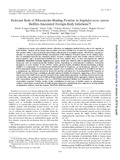Mostrar el registro sencillo del ítem
Relevant role of fibronectin-binding proteins in Staphylococcus aureus biofilm-associated foreign-body infections
| dc.creator | Vergara Irigaray, Marta | es_ES |
| dc.creator | Valle Turrillas, Jaione | es_ES |
| dc.creator | Merino, Nekane | es_ES |
| dc.creator | Latasa Osta, Cristina | es_ES |
| dc.creator | García Martínez, Begoña | es_ES |
| dc.creator | Ruiz de los Mozos Aliaga, Igor | es_ES |
| dc.creator | Solano Goñi, Cristina | es_ES |
| dc.creator | Toledo Arana, Alejandro | es_ES |
| dc.creator | Penadés, José R. | es_ES |
| dc.creator | Lasa Uzcudun, Íñigo | es_ES |
| dc.date.accessioned | 2019-01-23T11:16:19Z | |
| dc.date.available | 2019-01-23T11:16:19Z | |
| dc.date.issued | 2009 | |
| dc.identifier.issn | 0019-9567 (Print) | |
| dc.identifier.issn | 1098-5522 (Electronic) | |
| dc.identifier.uri | https://hdl.handle.net/2454/32080 | |
| dc.description.abstract | Staphylococcus aureus can establish chronic infections on implanted medical devices due to its capacity to form biofilms. Analysis of the factors that assemble cells into a biofilm has revealed the occurrence of strains that produce either a polysaccharide intercellular adhesin/poly-N-acetylglucosamine (PIA/PNAG) exopolysaccharide- or a protein-dependent biofilm. Examination of the influence of matrix nature on the biofilm capacities of embedded bacteria has remained elusive, because a natural strain that readily converts between a polysaccharide- and a protein-based biofilm has not been studied. Here, we have investigated the clinical methicillin (meticillin)-resistant Staphylococcus aureus strain 132, which is able to alternate between a proteinaceous and an exopolysaccharidic biofilm matrix, depending on environmental conditions. Systematic disruption of each member of the LPXTG surface protein family identified fibronectin-binding proteins (FnBPs) as components of a proteinaceous biofilm formed in Trypticase soy broth-glucose, whereas a PIA/PNAG-dependent biofilm was produced under osmotic stress conditions. The induction of FnBP levels due to a spontaneous agr deficiency present in strain 132 and the activation of a LexA-dependent SOS response or FnBP overexpression from a multicopy plasmid enhanced biofilm development, suggesting a direct relationship between the FnBP levels and the strength of the multicellular phenotype. Scanning electron microscopy revealed that cells growing in the FnBP-mediated biofilm formed highly dense aggregates without any detectable extracellular matrix, whereas cells in a PIA/PNAG-dependent biofilm were embedded in an abundant extracellular material. Finally, studies of the contribution of each type of biofilm matrix to subcutaneous catheter colonization revealed that an FnBP mutant displayed a significantly lower capacity to develop biofilm on implanted catheters than the isogenic PIA/PNAG-deficient mutant. | en |
| dc.description.sponsorship | This work was supported by the BIO2005-08399 and ERA-NET Pathogenomics (GEN2006-27792-C2-1-E/PAT) grants from the Spanish Ministerio de Ciencia, the Euroinnova Navarra-INNOVATIC program from the Gobierno de Navarra, and the Staph Dynamics LSHM-CT-2006-019064 grant from the European Union. | en |
| dc.format.extent | 14 p. | |
| dc.format.mimetype | application/pdf | en |
| dc.language.iso | eng | en |
| dc.publisher | American Society for Microbiology | en |
| dc.relation.ispartof | Infection and immunity, vol. 77, nº 9, sept. 2009, p. 3978–3991 | en |
| dc.rights | © 2009, American Society for Microbiology. All Rights Reserved. | en |
| dc.subject | Fibronectin-binding proteins | en |
| dc.subject | Staphylococcus aureus | en |
| dc.subject | Infections | en |
| dc.title | Relevant role of fibronectin-binding proteins in Staphylococcus aureus biofilm-associated foreign-body infections | en |
| dc.type | info:eu-repo/semantics/article | en |
| dc.type | Artículo / Artikulua | es |
| dc.contributor.department | IdAB. Instituto de Agrobiotecnología / Agrobioteknologiako Institutua | es |
| dc.rights.accessRights | info:eu-repo/semantics/openAccess | en |
| dc.rights.accessRights | Acceso abierto / Sarbide irekia | es |
| dc.identifier.doi | 10.1128/iai.00616-09 | |
| dc.relation.publisherversion | https://doi.org/10.1128/iai.00616-09 | |
| dc.type.version | info:eu-repo/semantics/publishedVersion | en |
| dc.type.version | Versión publicada / Argitaratu den bertsioa | es |
| dc.contributor.funder | Gobierno de Navarra / Nafarroako Gobernua | es |


